

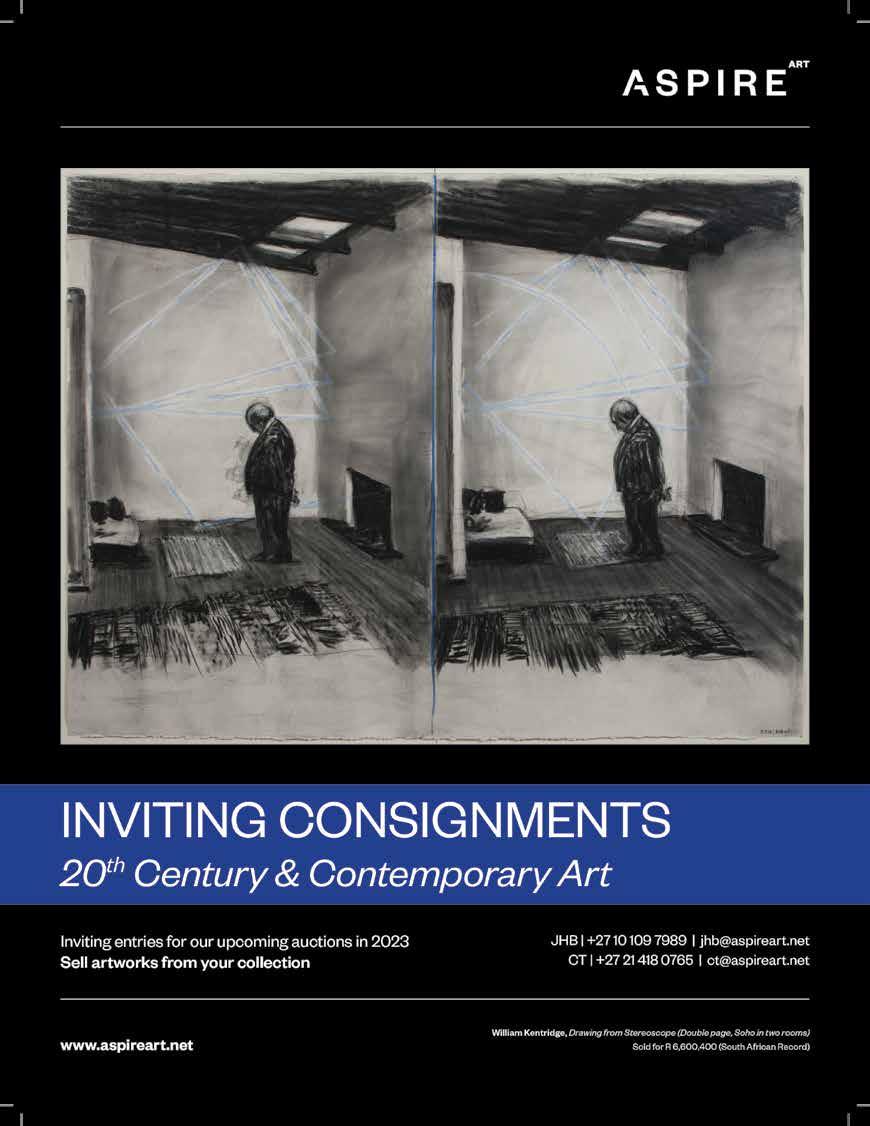




Collecting art can be a lifelong journey filled with discovery and lasting rewards. But starting can be daunting, writes Layla Leiman
The art world can be intimidating and overwhelming and it can feel daunting to know what “good art” looks like.
As a guiding principle, heed the advice most commonly shared by art industry experts and seasoned collectors: only buy art you want to live with and love. “There are various motivations for acquiring art, but the one I advocate is the essential motivation,” says Makgati Molebatsi of Mak’Dct Art Advisory & Agency, “acquire art that you connect with, that resonates with you and brings you joy.”
Training your eye and learning to recognise what resonates with you is really the first step on your collecting journey. There are numerous ways to gain knowledge and insight, and most are free.
Alexia Walker of Walker Art advisory suggests you begin by “viewing as much art as possible in person.” Visiting galleries, museums, art fairs and auctions and speaking to art industry experts will help build a context from which to cultivate your personal preferences and train your eye. As you see more art, you will begin to understand the difference between various techniques, mediums, and styles used by different artists. Most importantly, you will train your mind and eye to identify the types of art that resonate with you.
Molebatsi advises viewing art with an engaged gaze: “When looking at an artwork you are drawn to, before trying to get the
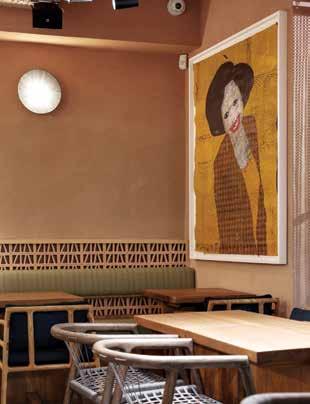

message, engage with the artwork. Allow these thoughts to go through your mind: what am I looking at – is it a painting, a sculpture, a photograph, an installation, a moving image? What is the medium, what is it made of – oil, acrylic, pastel, watercolour? Is it on canvas, board or paper? If you are unsure, ask the gallerist or the artist, this will allow you to engage and educate yourself. Notice every visual element or imagery in the artwork, take in the narrative content, and what it reminds you of – this will lead you to the message the artist is trying to communicate, their references and symbolism.”

Take advantage of the vast information available online, from artist biographies and interviews to exhibition reviews and critical essays. As your knowledge grows, you will be able to recognise where a particular artist’s work sits within the contemporary art landscapes. Follow artists, galleries, critics and curators on Instagram, but don’t get swept up in trends; know your own mind.
“Collecting art is a personal journey and there are multiple associated rewards,” Walker explains. “Whatever the personal motive, collecting art creates value in one’s life.”
JH Pierneef; Kremetartboom, Bosveld, N.T.
“Acquire art that you connect with, that resonates with you and brings you joy.”
– Makgati Molebatsi
As you refine your eye and gain confidence in your preference, the next hurdle is where and how to purchase artwork. This will be informed largely by your budget, but anyone can build an art collection that is meaningful to them!
Early-career artists are an excellent entry point for new and seasoned collectors. In addition to these artists’ work being more affordable than established artists, it also offers the thrill of discovery. Those immersed in the art world might look for work at graduate exhibitions or buy directly from artists from their studios or through Instagram.



Galleries such as Gallery2, Guns & Rain, and THK Gallery; online platforms such as Latitudes Online; specialist limited print studios such as 50ty/50ty, South Atlantic Press, David Krut, and Artist Proof Studio; and art fairs such as Turbine Art Fair, are ideal for those who prefer more formal channels. The Turbine Art Fair in Johannesburg, for example, has three special projects specifically focused on showcasing emerging artists: those who have been through a mentorship programme, top graduates from tertiary institutions, and mid-career artists not currently represented by a gallery. Founder and director Glynis Hyslop explains that “each of these gives collectors access to artists not yet in the gallery or collective world.”
Acquiring works by higher-profile artists from galleries with an international footprint can require patience and perseverance. This is where the secondary market can be useful. Strauss & Co art specialist Arisha Maharaja explains that “through specialist art auction houses, you will be able to look through high-quality sales and find rare works that are hard to get your hands on.”
Unlike the primary market (galleries, etc.) the secondary market (auctions) sets prices based on previous sales records,
which are publicly available. In addition to being transparent and democratic, auctions offer a wide variety with the potential of good value. “The obvious advantage of buying at auction is that you are likely to get a good deal on an item,” Maharaja says. “Auction pre-sale estimates are generally lower than retail prices as they are in accordance with the market for each artist. And, in some cases, there is likely to be a lower reserve where you could potentially get an amazing artwork for a steal!”
While collecting art is a lot about the thrill of discovery and making the purchase, living with your art at home is where the journey really begins. Q
Alexia Walker: “Familiarise yourself with the fee structure. First buyers are often unaware of the costs that come on top of the hammer price, this takes away from the excitement of buying on auction.”
Alexia Walker: “There are artworks priced for every pocket, even at the top galleries. Speak with the staff and ask them to show you works not currently displayed. They might have limited editions or works on paper by your favourite artists that are more accessible.”
Makgati Molebatsi: “Engage the gallery and obtain as much information as you can about the artist and the artwork, and negotiate. Sometimes the negotiation may be unachievable when the artist is in demand and there is a waiting list, but always ask. Some galleries may provide terms for premium priced artworks, you may never know if you do not ask.”
Stephan Welz & Co as a premium auction house, we are accustomed to handling South African masters such as Jacob Hendrik Pierneef, Maggie Laubscher and Irma Stern’s to name a few. As a courtesy to our clients, we are now offering a free professional cleaning service when you consign South African masters with us. Contact us to meet with one of our departmental


Founded in 2021 by artist and art entrepreneur Musa N Nxumalo, Studio Nxumalo Contemporary has operated as a collaborative visual arts venture, working closely with artists and art galleries, art institutions and hospitality spaces to develop exhibitions. Studio Nxumalo is now moving into a dedicated gallery space at Keyes Art Mile, with an art programme dedicated to independent, emerging and established (South) African artists.


“After nearly four years working as an in-house curator at a commercial art gallery, my love for art coupled with my experience in the business of art, became a central focus as I found myself being increasingly approached by independent and emerging artists looking to exhibit, engage about their portfolios, or promote and sell their work,” says Nxumalo. “Inspired by the needs and dedication of such artists, Studio Nxumalo Contemporary was developed as a platform for local artists to gain exposure.
“Until now, Studio Nxumalo has operated without a fixed space, allowing us entry into the fine arts industry without the need to invest in major commitments such as leasing premises and employing a team,”



Studio Nxumalo has entered a new era with its move to a dedicated gallery space

Nxumalo explains. “This freedom and flexibility has, until now, afforded us the opportunity to invest exclusively into our real passion – artists. Under the motto ‘I take care of artists’, we have worked with thirty-six artists since our inception and, after careful consideration, fi nd this an opportune moment to take the next step in our journey.
“By establishing a gallery space, we aim to create opportunities for a wider base of independent and emerging artists to access group and solo exhibitions, sell work, and bring greater visibility to their portfolios. The space also seeks to open up new possibilities for projects, collaborations, and exhibitions by artists working outside of Johannesburg/South Africa.
“We envision an inclusive space for emerging and independent artists, where we can grow together while navigating the business of fine art in our local context, and find solutions to the challenges we encounter along the way. The generous support of more established practitioners has thus far enabled us to sustain our vision and make a positive contribution to early career artists. We are excited to usher in this new era of Studio Nxumalo and look forward to the opportunities it will afford artists, audiences and art collectors alike,” Nxumalo says.

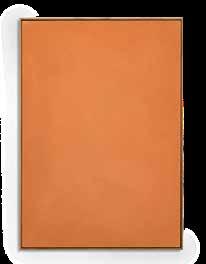
Inga Somdyala, Hlathi , ochre on canvas, 2022. Courtesy of WHATIFTHEWORLD.
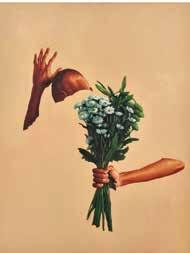


RESERVOIR, founded by Heinrich Groenewald and Shona van der Merwe, has partnered with contemporary galleries such as WHATIFTHEWORLD, THK, and TheFOURTH to exhibit some of South Africa’s exciting young artists.

R10 000 – “We love John Phalane’s colour pencil drawings, especially his series of cities across the world. His iconic hotels and waterfronts are strangely cubist and unpopulated with searing blue skies.”
R50 000 – “Inga Somdyala’s earth-stained ‘paintings’ epitomise simplistic beauty, and this tension of the landscape’s shrouded seduction is something we find hugely successful in his practice.”
R150 000 – “Commission an artist such as Katharien de Villiers to build one of her absurdist participatory sculpture installations.”
Independent curator and art advisor Amy Ellenbogen works across diverse projects, including developing exhibitions for artists, conceptualising residencies, and designing products.
R10 000 – “I’d select a Johno Mellish photograph. His informed and technically brilliant eye make for one-of-a-kind images.”
R50 000 – “Anna Van der Ploeg is the most fascinating female artist for me right now. Her monotypes and sculptural work explore humour and pain, and she can mix media with mastery.”
R150 000 – “I am the world’s biggest Cameron Platter fan!
Cameron is a constant mirror for me, holding up my love and childhood in his subject matter and constantly making me smile.”
Founded by artist and curator Musa N Nxumalo, Studio Nxumalo is a versatile platform that works closely with artists, galleries, institutions and hospitality spaces. Since September 2022, Studio Nxumalo has occupied a dedicated gallery at Keyes Art Mile in Johannesburg with a programme focused on independent, emerging and established South African artists. Across the three price brackets, Nxumalo highlighted artists he will be working with soon through his gallery:
R10 000 – Lebogang Mogul Mabusela

R50 000 – Mfundo Mthiyane
R150 000 – Layziehound Coka
“These artists are highly skilled and have been consistent in their practice, showing exceptional growth artistically and commercially,” Nxumalo explains.
Who would the experts put on their walls for R10 000, R50 000 and R150 000?Mfundo Mthiyane, A Metaphor III, 2022. Courtesy of Studio Nxumalo. Anna van der Ploeg, Five hours refusing to eat, oil on cotton, 2020. Courtesy of the artist. Musa N Nxumalo Amy Ellenbogen Mfundo Mthiyane, The Human Condition, 2022. Courtesy of Studio Nxumalo. Shona van der Merwe and Heinrich Groenewald . Photo by Mikhailia Petersen


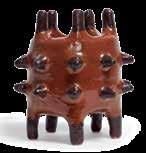
Our relationship with clay dates back almost 30 000 years. Throughout history and around the world, we’ve used this malleable and versatile material to fashion essential everyday objects and intricately wrought works of art. Because of clay’s innate functionality, ceramics have often been relegated to the category of craft or decorative arts. Recently, however, this ancient material has seen a resurgence of popularity, with ceramic artists breaking the mould to redefine and reimagine the medium.
Andile Dyalvane’s large-scale complex ceramic artworks draw inspiration from Xhosa cultural traditions and contemporary abstract expressionism. Richly textural, with vibrant bursts of colour reminiscent of aloes in the Eastern Cape landscape, Dyalvane’s vessels are imbued with ancestral knowledge passed down through generations.

Hylton Nel,

For more than five decades of working with clay and glazes, Hylton Nel has developed a distinct visual language. His plates, bowls, vases, plaques and figurative pieces are idiosyncratically decorated with witty and sometimes poignant line drawings and text. Nel describes himself as an “artist-potter”, which aptly encapsulates his interest in painted imagery, form and function.

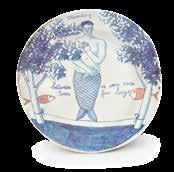

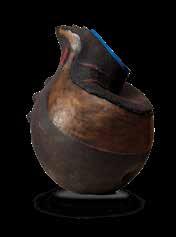
Ben Orkin, Love Alone Not Alone I, 2021. Courtesy of WHATIFTHEWORLD.

Ben Orkin’s sculptural ceramic vessels offer enigmatic reflections on queer intimacy. In the curves and protrusions, recessions and cavities, a tactile body language is made visible. The sensual abstract forms have a textured finish, evidence of the artist’s hand and careful touch.
Hylton
Ben Orkin, Wipe Out The Past, 2021. Courtesy of WHATIFTHEWORLD.
For contemporary artist Lucinda Mudge, ceramic vases are a canvas for complex narratives told in rich colours and intricate detail. Painstakingly created over many months, each vase tells a unique story that is at once irreverent and critically astute. Mixing historical and pop cultural references, Mudge’s mesmerising vases are whimsical collisions of the popular and refined, the mundane and elevated, the violent and the beautiful.
magic of

When moving into a new house, you’re only considered well and truly home once your art is on the walls. Here are some helpful principles to maximise the impact of your art pieces. While art is a long-term investment for some, art in your home yields returns every day. Artist Banele Khoza, who runs BKhz gallery on Keyes Art Mile, explains the number-one rule for collecting: “You will be living with the artwork, so only buy what you love.”
Whether you’ve just started or have an established collection, you’ll need to choose what goes up. If you’re having trouble deciding, Khoza suggests showing your works on rotation rather than all at once. It’s standard practice at art fairs and exhibitions. Camilla van Hoogstraten from Latitudes Online, a curated marketplace for art from Africa, describes the importance of the relationships between works: “Art is all about storytelling. I suggest grouping artworks together according to common themes or motifs. Grouping works of different media together makes for an interesting visual experience. When done correctly, juxtaposition highlights certain facets in each work, bringing elements such as colour or texture to the forefront.”
“Your key artworks should always be close to eye level,” says curator of Decorex Africa and creative director Bielle Bellingham. “One of the most common mistakes is to hang works too high.” Unless it’s going above a furniture piece, in which case, she recommends eyeballing it. “This is not exactly a science, but more of an intuitive decision on what feels good to you. Trust yourself!”
Another common question is whether to match wooden frames to your wooden furniture. “The brat in me likes to match all my timbers,” Bellingham admits, “but I also believe in making the best of what we have, instead of replacing perfectly good options.” If you’re getting custom frames made, an expert framer will be able to match the frames to wooden pieces in your home.
Going to framers with fine art experience could save you money in the long run. Marianne Schwankhart from fine art framers David-Lewis Browne strongly suggests conservation framing for investment artworks and acid-free framing for less valuable pieces.
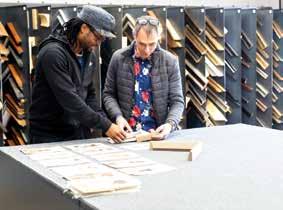

“When considering the placement of artworks in a house, the determining factor should always be light,” van Hoogstraten says. “In darker spaces, steer away from works with dark underlying tones and avoid having too many pieces in the room. Both can make a room seem smaller than it is. Instead, consider large works of art that are bright or have lighter undertones for darker rooms.”
Schwankhart cautions to keep an artwork out of direct sunlight, as UV rays can cause fading. While paintings on canvas or board need not be behind glass, works on paper are best kept behind museum glass or perspex with a high UV filter. These surfaces also have less reflection, so the artworks can be viewed more clearly.
Interior designer and founder of Arrange Studio Roxanne Ferreira suggests flexible track lighting with individually adjustable spots. “Globes with a wider beam angle that wash your artworks with a soft, even light are ideal, as you want to avoid creating a sharp ‘hot spot’ of light on one area of artwork. Aim for the centre of the artwork rather than the top to avoid distracting the eye. As for the type of light, approximating daylight with colour temperatures of 3 000–5 000 Kelvin is a good rule of thumb.” Q
Let your artwork shine through thoughtful framing and curation, writes Alix-Rose CowieArrange Studio.
“Grouping works of different media together makes for an interesting visual experience.”
– Camilla van HoogstratenDavid-Lewis Browne framers.



Choose what you like. Is there a specific photographer or artist’s work that you find fascinating, a theme or subject matter that is of interest to you, or a particular period that is important?
Understand editions. The number of editions limits the versions of a photograph circulated in the market, thereby maintaining value. Editioning also ensures a level of scarcity and verifies the authenticity of a particular photograph.
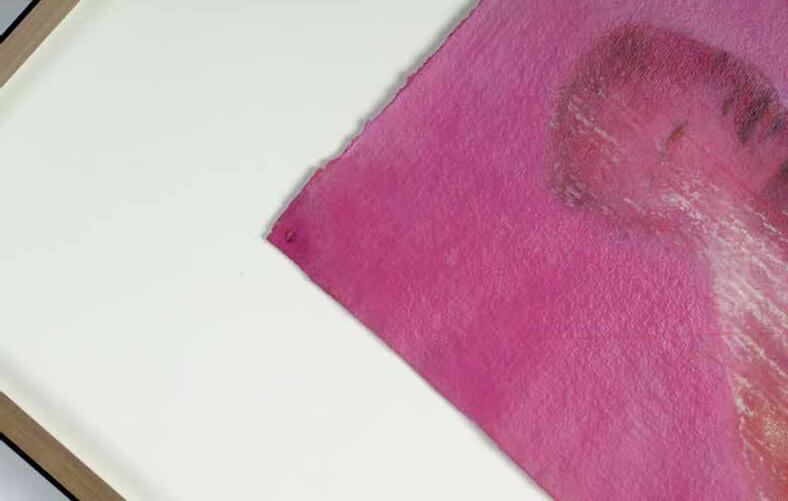
Inspect signatures and inscriptions and ask for certificates of authenticity. See if the photograph is signed, dated and inscribed with a title or any other relevant information, otherwise obtain a certificate signed by the artist or auction house to confirm its authenticity.
Look at the photography process and print. Various distinct photographic processes reveal the technical and creative skill involved in creating a particular photographic image, as well as the quality of the physical photograph. Determine if it is a film or digital photograph.
The Rupert Museum, based in Stellenbosch, is home to a superb collection of Modern South African art collected from 1940 to early 2000 by the late Dr Anton Rupert and his wife Huberte Rupert. The museum also manages other corporate collections highlighting Modern French tapestries and Italian paintings and sculptures.
The museum’s public programmes include a diverse spectrum of activities for everyone. Programmes include Yoga Thursday, Walkabouts on Wednesdays and Fridays and Museum Saturdays.
The vibrant Museum Saturdays, which take place on the last Saturday of every month, boast artist talks, walkabouts, master and kid’s workshops, a pop-up menu from the Museum Café, and live music with tastings ranging from wine and whiskey to beer and champagne.
The spaces, such as the active library and vibrant Museum Café, are open for all to enjoy.
Marelize van Zyl, senior art specialist at Aspire Art, shares tips on how to get your collection started